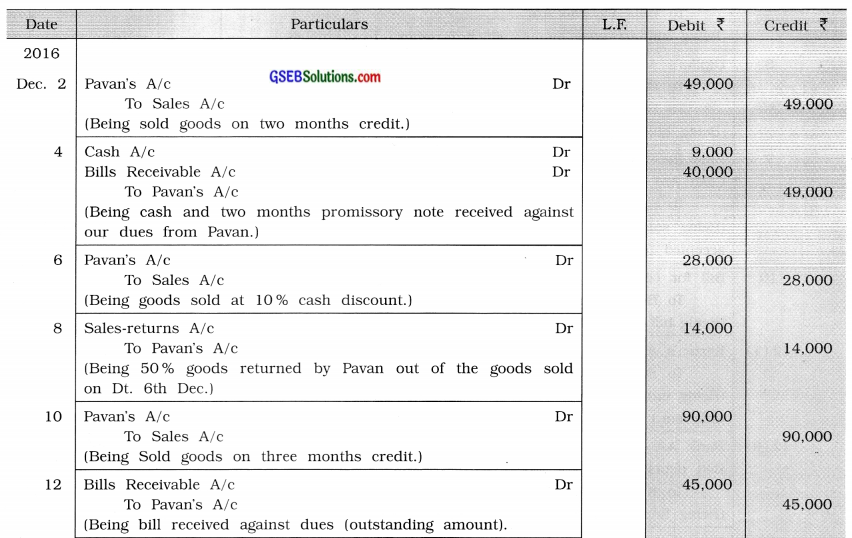Gujarat Board GSEB Textbook Solutions Class 11 Commerce Accounts Part 2 Chapter 4 Bills of Exchange Textbook Exercise Questions and Answers.
Gujarat Board Textbook Solutions Class 11 Accounts Part 2 Chapter 4 Bills of Exchange
GSEB Class 11 Accounts Bills of Exchange Text Book Questions and Answers
Question 1.
Write the correct option from those given below each question:
1. Generally, who writes (draws) a bill?
(a) Debtor
(b) Creditor
(c) Creditor
(d) Bank
Answer:
(b) Creditor
2. Generally. who accepts a bill?
(a) Debtor
(b) Government
(c) Creditor
(d) Bank
Answer:
(a) Debtor
3. Who writes (draws) a promissory note?
(a) Insurance Company
(b) Creditor
(c) Debtor
(d) Government
Answer:
(c) Debtor
4. In order to facilitate the payment of money in the transaction of bill, ……………………….. days of grace are allowed.
(a) four
(b) one
(c) three
(d) two
Answer:
(c) three
![]()
5. Before the date of maturity of a bill, from whom is it discounted by the drawer of a bill?
(a) Debtor
(b) State government
(c) Central government
(d) Bank
Answer:
(d) Bank
6. Bill is an instrument under which act?
(a) Indian Company Act, 2013
(b) Partnership Act, 1932
(c) Indian Contract Act, 1872
(d) Indian Negotiable Instrument Act, 1881
Answer:
(d) Indian Negotiable Instrument Act, 1881
7. When the court declares a person as an insolvent, it also appoints an officer for the purpose of distribution (collection) of assets and payment to creditors is known as the ……………………… :
(a) Receiver
(b) Government advocate
(c) Wellknown advocate
(d) Notary
Answer:
(a) Receiver
8. Renewal of a bill means …………………. .
(a) old bill is being written again in good handwriting.
(b) new revenue stamp is affixed on old bill.
(c) new bill with new period is drawn against old bill.
(d) Bill is sent by e-mail against old bill.
Answer:
(c) New bill with new period against old bill.
Question 2.
Answer the following questions in one or two sentences:
1. Define a bill.
Answer:
The definition of a bill of exchange as per the Indian Negotiable Instruments Act, 1881 is as follows :
“A bill of exchange is an instrument in writing containing an unconditional order, signed by the drawer, directing a certain person to pay a certain sum of money only at a specified time to a certain person or according to his order or to the holder of the instrument.”
2. Define a promissory note.
Answer:
The definition of a promissory note as per the Indian Negotiable Instruments Act, 1881 is as follows :
“A promissory note is an instrument in writing containing an unconditional undertaking, signed by the drawer to pay a certain sum of money only at a specified time to a certain person or according to his order or to the holder of the instrument.”
3. How many parties are there in a bill?
Answer:
There are three parties in a bill:
- Drawer of a bill,
- Acceptor of a bill and
- Receiver of money, it means payee of a bill.
4. How many parties are there in a promissory note?
Answer:
There are two parties in a promissory note :
- Drawer or Maker of a promissory note and
- Payee or Receiver of money.
![]()
5. What is the terms of bill?
Answer:
Some period is allowed for the payment by the bill drawer to the bill acceptor, it’s called terms of bill.
6. What is the maturity date of a bill?
Answer:
The maturity date of a bill means the date on which the amount is payable by the acceptor of the bill. The maturity date of a bill can be derived by adding the period of the bill to the date on which the bill is drawn.
7. What are the days of grace?
Answer:
In order to facilitate the payment of money in the transaction of bill, three days of grace are added to the date which is derived after adding the period of the bill to the date of drawing the bill. This additional three days are called days of grace.
8. What is bill at sight?
Answer:
The acceptor of the bill is required to pay the amount of the bill immediately whenever the person holding the bill demands the payment. Such a bill is known as a bill at sight.
9. What is bill after dated?
Answer:
The acceptor of the bill is required to pay the amount of the bill after a definite or stipulated period. Since a definite period is allowed for the payment of the amount of the bill, it is known as a bill after dated.
Question 3.
Answer the following questions in detail:
1. Define bill and state its characteristics.
Answer:
Meaning: A bill is a written document sent by a creditor to his debtor, stating an unconditional order to pay the certain amount in specified time, according to his order or to the holder of the document.
Definition: A bill is an instrument in writing containing an unconditional order signed by the drawer of the bill, directing to pay a certain sum of money only, at the specified time to a certain person or according to his order or to the holder of the document.
Characteristics of bill
- The bill must be in writing.
- In a bill, the writing must be in order but not in a request form.
- An order made in the bill should be unconditional.
- In this order, it is mentioned to pay certain amount to a certain person or according to his order or to the holder of the bill.
- In a bill, the signature of the drawer of a bill is the must.
- The prescribed amount of revenue stamp (not postal stamp) must be affixed on the bill.
- The bill becomes operative only after it is accepted by the acceptor of a bill.
- The bill is drawn by a person addressing it to the other person. Means, there must be three parties – the drawer, the acceptor and the receiver of money (payee).
- The holder of the bill will be paid the amount at the end of certain period.
- The duration/period of the bill must be definite.
- The date of writing the bill must be definite.
- The amount shown in the bill must be clear and definite. The amount is shown both in figures and words.
2. Give the specimen of a bill and explain its details.
Answer:
Specimen of a Bill
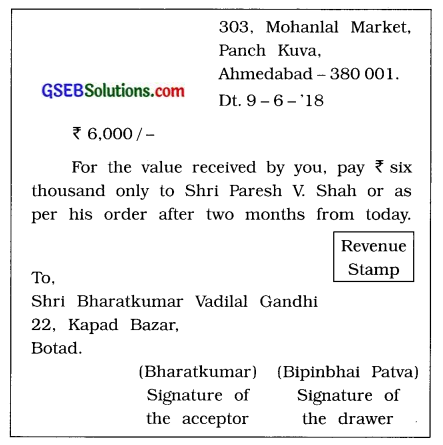
Details of the bill: From the above specimen of bill following details of the bill is available :
1. Parties :
1. Drawer of the bill: Shri Bipinbhai Patva
2. Acceptor of the bill: Shri Bharatkumar Vadilal Gandhi
3. Receiver of money: Shri Paresh V. Shah
2. Amount: The amount payable by the acceptor must be clearly shown in the bill. The amount is generally shown both in figure and words, e.g., In the above specimen, it is shown as ₹ 6,000 and Rupees six thousand only.
3. Date: In the specimen given above, the date of the bill is 9-6-18. The date is an important part of a bill because the maturity date of the bill depends on the date of the bill and the period of the bill.
4. Period: The period after which the amount is payable, that period must be shown clearly in the bill. In the specimen given above, the period is two months.
5. Revenue stamp: For legal recognition, it is necessary to affix a revenue stamp in the proportion of the amount of the bill.
6. Signature: The signature of the drawer and acceptor of the bill are must in the bill.
7. Types of bills: There are two main types of bills :
- Bill at sight and
- Bill after dated (time).
![]()
3. Define promissory note and state its characteristics.
Answer:
Meaning: Promissory note means, a written promise given by a debtor or payer of money to his creditor, for the payment of money after certain period. Promissory note is also a instrument, just like a Bill of exchange to clear the debt and dues.
Definition: Promissory note is a written document signed by the maker, for the value received, giving an unconditional undertaking to pay a certain amount to a specified person or to the holder of the document or to his order.
Characteristics of a Promissory note:
- Promissory note is written by a debtor.
- In promissory note an unconditional written promise of paying the money is given.
- Payable amount is to be given to a specified person or to the holder of the document or to his order.
- Amount mentioned in the promissory note must be definite.
- Signature of drawer of promissory note is required.
- According to the amount of the promissory note, necessary amount of revenue stamp must be affixed.
- If the date is not stated on the promissory note the date on which the promissory note is delivered is treated as the date of promissory note.
- ‘To pay the bearer’ such promissory note is not seen in the transaction because such a promissory note becomes a currency note.
- Promissory note is written by the debtor himself, therefore the question of acceptance does not arise.
There are two parties in a promissory note :
- Drawer or Maker of the promissory note and
- Receiver of money (Payee.)
A promissory note can be drawn jointly by more than one person. In this case, each person becomes jointly and individually responsible for making the payment.
The duration of the promissory note must be clearly stated.
4. Give the specimen of a promissory note and explain its details.
Answer:
Specimen of Promissory Note
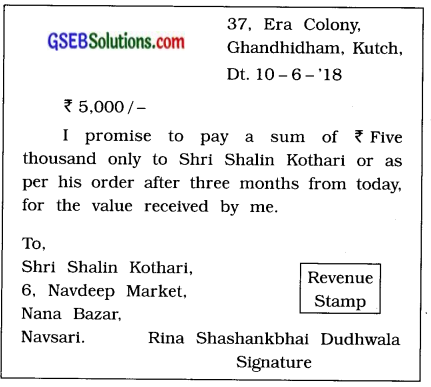
Details of the Promissory note: From the above specimen of Promissory note, following the details of the promissory note is available :
1. Parties:
1. Drawer of promissory note: Rina Shashankbhai Dudhwala.
2. Receiver of money: Shri Shalin Kothari
2. Amount: The amount payable by the drawer (maker) should be clearly stated in the promissory note. The amount is generally shown both in figure and words, e.g., In the above specimen, it is shown as ₹ 5,000 and Rupees live thousand only.
3. Date: Generally, the date on which the promissory note is drawn (made), the same date is to be shown on the promissory note. Here date of promissory note drawn is 10-6-18.
4. Period: The period after which the amount is payable, that period must be shown clearly in the promissory note. In the specimen given above, the period is three months.
5. Signature: It is necessary that the promissory note is signed by its drawer (maker) in order to make the note a legally valid document. In the above specimen, Rina Shashankbhai Dudhwala is the maker of the promissory note, so her signature on the note is essential.
6. Revenue stamp: For legal recognition, it is necessary to affix a revenue stamp in the proportion of the amount of the promissory note.
5. Explain the difference between Bill of Exchange and Promissory Note.
Answer:
| Difference | Bill of Exchange | Promissory Note |
| 1. Meaning | A bill of exchange is an instrument in writing containing an unconditional order, signed by the drawer, directing a certain person to pay a certain sum of money only at a specified time to a certain person or according to his order or to the holder of the instrument. | A promissory note is an instrument in writing containing an unconditional undertaking, signed by the drawer to pay a certain sum of money only at a specified time to a certain person or according to his order or to the holder of the instrument. |
| 2. Order or Promise | A bill of exchange is an unconditional order to pay money. | A promissory note is an unconditional promise to pay money. |
| 3. Parties | There are three parties in a bill of exchange: 1. Drawer of a bill, 2. Acceptor of a bill 3. Receiver of money (Payee) |
There are two parties in a promissory note: 1. Drawer of a promissory note 2. Receiver of money (Payee) |
| 4. Drawer or Writer | Creditor draws the bill on debtor. | Debtor writes promissory note oh creditor. |
| 5. Acceptance | The acceptance of a bill is necessary. | The acceptance of a promissory note is not necessary. |
| 6. Responsibility | Responsibility for the payment of money is of the acceptor of a bill. | Responsibility for the payment of money is of the drawer of a promissory note. |
| 7. Days of grace | Three days of grace are allowed after tire period of the bill to pay the amount. | No days of grace are allowed in case of promissory note. |
| 8. Receivable or Liability | A bill is a ‘receivable’ (asset) for the drawer of a bill. | A promissory note is a liability for the writer of promissory note. |
| 9. Accommodation | There can be accommodation bills. | There are no accommodation promissory note. |
| 10. Notice | Notice is to be issued in case of dishonour of the bill. | There is no need of notice for the dishonour of a promissory note. |
6. What is bill receivable and bill payable?
Answer:
Bill receivable: It is a bill receivable for the person who draws the bill. Generally, drawer of a bill receivable is a creditor. A bill receivable is an asset for the drawer of the bill.
e.g., Sona has to receive ₹ 9,000 from Rupa. Here, Sona would draw a bill of ₹ 9,000 on Rupa and Rupa would accept the same. In this situation, this bill is a bill receivable for Sona.
When the drawer of the bill and the payee are different persons, then it is considered to be a bill receivable for the holder of the bill.
Bills receivable shows as current asset in the Balance Sheet.
Bill payable: It is a bill payable for the person who accepts the bill. Generally, acceptor of a bill is a debtor. A bill payable is a liability for the drawee (acceptor) of the bill.
Bills payable shown as current liabilities in the Balance Sheet.
In the above illustration, a bill is a bill payable for Rupa.
![]()
7. Explain the main four methods or alternatives of the disposal or uses of a bill.
Answer:
The drawer of the bill or the holder of the bill can dispose off the bill by any one of the methods mentioned below:
1. To keep the bill with him up to the date of maturity: If the drawer of the bill is not in need of money earlier than the date of maturity or if the period of the bill is very short, he keeps the bill with him up to the date of maturity and collects the money on the date of maturity from a debtor (acceptor of bill).
2. To discount the bill: If the holder of the bill is in need of money, before the maturity date of the bill, he gets money by discounting the bill with the bank or with the shroff. In this way, while discounting the bill, bank or shroff deducts the interest from the date on which the amount is paid, up to the legal date of maturity of the bill. This amount is known as discount for the trader who discounted the bill. In this way holder of the bill will loose the ownership right and bank or shroff will get the ownership right. Therefore, on maturity date of the amount of the bill will be received by the bank or shroff from the acceptor of the bill.
3. To endorse a bill: A bill is a transferable document (Negotiable instrument). Therefore the holder of the bill, with the consent of his creditor, clear his debt by giving the bill receivable against his debts, by making note and necessary signature behind the bill. This process is known as endorsement of a bill. On maturity date the amount will be collected by the creditor.
4. To give (To send) the bill for collection: In the business when transactions of bills are more and if the trader is busy in his various business activities, then for the purpose of time saving and facility, he gives such work of collecting money of the bill, on the date of maturity, to the bank or to the shroff. For this, he sends the bill to the bank or shroff before the date of maturity of the bill. Bank or shroff collects money on behalf of the trader. Bank or shroff acts as an agent and charge commission at a prescribed rate.
8. What is dishonour of a bill ? Discuss about the entries of the dishonour of a bill.
Answer:
Dishonour of bill : Sometimes the acceptor of the bill is not in a position to pay the money of the bill or not willing to make the payment of the bill, then it is known as dishonour of a bill. Because of the money crisis, insolvency of the acceptor or because of the non-arrangement of money or because of the other reasons if the payment of the bill is not made by the acceptor of the bill then also it is known as dishonour of the bill and it should be informed in time to the concern parties by the holder of the bill.
Procedure for entry of a dishonoured bill: When the bill is dishonoured, the holder of the bill goes to the notary for the noting of an entry of such dishonoured bill. Such noting is not compulsory by law but it is advisable. When dishonoured bill is presented to this officer, he presents the bill again to the acceptor of the bill.
Now if the acceptor of the bill is not in a position to pay the money or money is not paid by him then notary record the entry of dishonour of a bill in his record books, and issues a certificate for noting of dishonour bill to the holder of the bill.
For making this entry the fees charged by the officer is called noting charges. The expense of noting charges is at the first instance paid by the holder of the bill and in due course he can collect the amount from the acceptor of the bill because the final legal responsibility for paying the noting charges is that of the acceptor of the bill.
9. Write a short note on insolvency of the acceptor of a bill.
Answer:
When the court declares the acceptor of the bill as insolvent, on the same date the drawer of the bill or the holder of the bill records the dishonoured of the bill in his books. The receiver, who is appointed by the court, obtains the possession of the assets of the insolvent person and also dispose them off and distributes the proceeds among the liabilities in the proportion of their legal rights.
This payment is made proportionately on the basis of the proceeds of the assets, which normally is not the entire amount. The payment so received is legally known as dividend. The amount not received by the creditor is recorded in his books as bad debts. In this way, the drawer tries to close the creditors account by debiting the amount received and amount of bad debts and crediting the creditor’s account (the account of the acceptor) whereas the acceptor or the insolvent himself records only that amount which he pays.
10. What is renewal of a bill? Which points are considered in that?
Answer:
Meaning of Renewal of a bill: Sometimes, when an acceptor of a bill is not in a position to pay the full amount of a bill on the due date, then the acceptor has to dishonour the bill. This has an adverse effect on his credit and prestige in the market and he has to face the legal procedure for the payment of the money of the bill. In these circumstances, the acceptor of a bill contacts the drawer of the bill before the maturity date of the bill and requests him to draw a new bill against the old bill for a new period. If the drawer of the bill agrees to his request, the old bill is cancelled and a new bill comes into existence. When a new bill for an extended period is given in exchange of an old bill, it is known as Renewal of a bill or change of bill period.
Points to be considered:
- Cancel the old bill considering it to be dishonoured and pass necessary journal entries in the books of both the parties.
- Calculate the interest on the additional period due to the extension of the period of the bill and record its accounting effects.
- Give the accounting entry for the acceptance of the new bill.
Why is interest calculated ?: At the time of the renewal of a bill, sometimes, acceptor of the bill pays some amount to the drawer of the bill and for the remaining amount drawer writes a new bill. At this time, for the payable amount acceptor of a bill has to pay the interest for the period of a new bill. This interest amount is an expense for the acceptor of a bill and therefore he will debit this amount to interest account, while for the drawer of the bill, this interest amount is an income and therefore he will credit this amount to interest account.
![]()
11. Write a short note on Accommodation bill.
Answer:
Accommodation bill: Generally, a creditor writes a bill for his dues to a debtor which is accepted by a debtor. This type of the document is known as bill. But sometimes two persons or traders, to fulfill their internal short term financial requirements writes the bill which is known as accommodation bill. The drawer of the bill, after receiving the bill (after acceptance), discounted this bill with the bank or shroff.
This money is used by both drawer and drawee, of the bill. After discounting the bill, the discount is borne by both the parties in proportion to the amount shared by the parties. Accommodation bill is not written for the settlement of the dues and debts or the bill is drawn without any consideration. The purpose of writing the bill is for accommodation of each other and to have money for some period. If creditability of both the parties in the market is sound and on due date if there is a possibility of payment then bank or shroff discounts this bill.
Forms of accommodation bill: Accommodation bill can be seen in three different forms as shown below:
1. The drawer of the bill keeps full amount of the bill with him: The drawer of the bill writes the bill for the accommodation of himself. After discounting the bill with bank or shroff, full amount of bill is kept by drawer himself and sends the amount of the bill to the acceptor of a bill before the date of maturity.
2. The amount of the bill is distributed in definite proporation: When both the parties are in need of money, then with mutual understanding, a bill for a specific amount is drawn by one party and another party accept it. Thereafter, the bill is dicounted with the bank or shroff, and the amount received is shared in agreed proporation and also share the discount amount accordingly. Before the date of maturity, the drawer of the bill sends proportionate amount to the acceptor of the bill.
3. Both the parties draw the bills on each other: In accommodation bill, if the drawer of a bill does not send his share of amount to the acceptor of a bill by the date of maturity, difficulty will arise for the acceptor. Hence, the other bill is drawn for the amount equal to the share of the drawer which will be accepted by the drawer of the first bill. Many times, both the parties draw the bills on each other for equal amounts so that the question will not arise for sending money before the date of maturity.
Question 4.
Answer the following questions :
1. Hetansh sold goods of ₹ 60,000 on two months credit to Hiren on 1-6 -’16. On 2-6-’16, Hetansh drew a bill of the necessary amount on Hiren, which Hiren accepted and returned. Hiren paid the money of the bill on the maturity date. Pass necessary journal entries in the books of both the parties.
Answer:
Journal of Hetansh
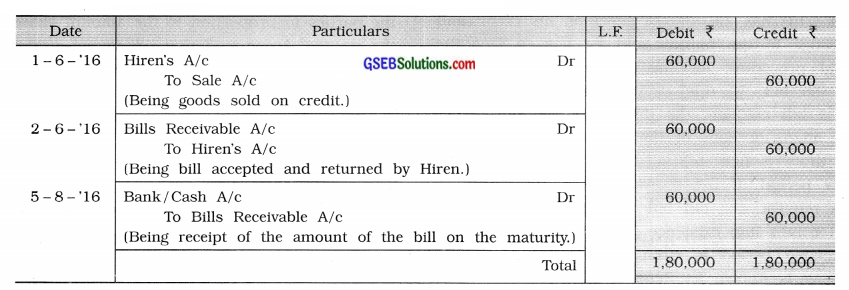
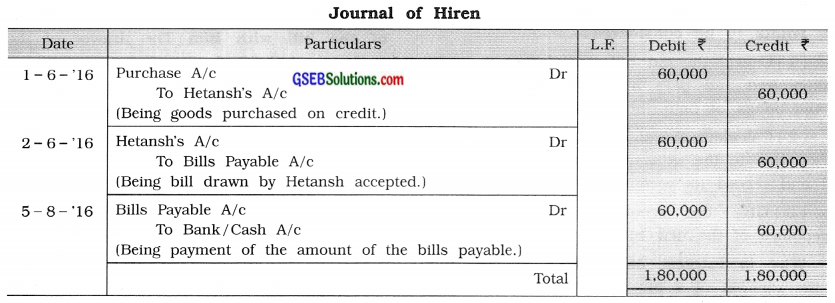
2. Sunny sold goods of ₹ 52,000 to Vishnubhai on 16-6-’16, against which Vishnubhai accepted a three months of bill of ₹ 52,000 on 20-6-’16. On 2-7-’16, Sunny discounted this bill with the bank at a discount of ₹ 520. Vishnubhai paid the bill on the maturity date. Pass necessary journal entries in the books of both the parties.
Answer:
Journal of Sunny
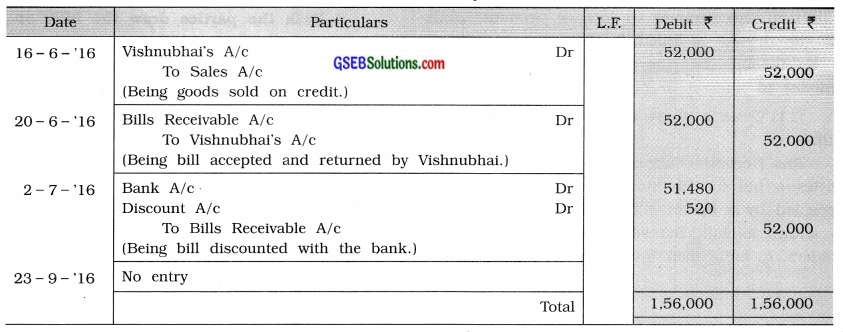

3. Palak sold goods of ₹ 48,000 on credit to Ansh on 15-5-’16. On the same day, Palak drew a bill on Ansh for 60 days, which Ansh accepted. On 25-5 -’16 Palak endorsed this bill in favour on a creditor Jinal. The amount of the bill was paid on the maturity date. Pass necessary journal entries in the books of Palak and Ansh.
Answer:

Journal of Palak
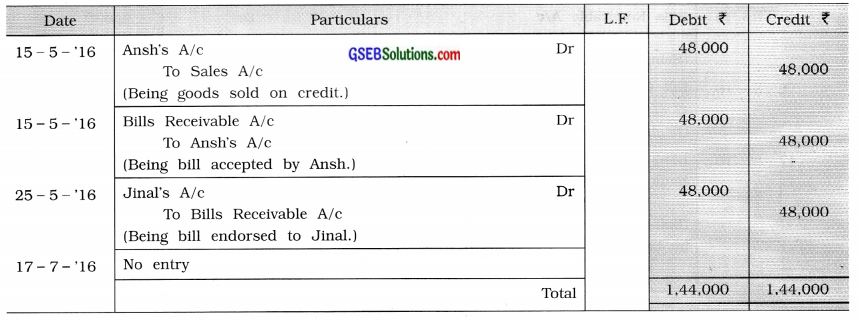
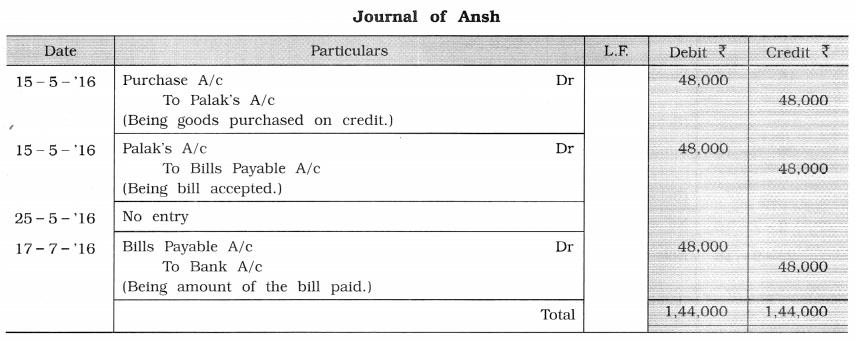
![]()
4. Sajid drew a bill of ₹ 28,000 for 2 months on Aamir on 14 – 6 – ’16. Aamir accepted and returned the bill. On 6-8-’16, Sajid sent this bill to the bank for collection. The bill was paid on the maturity date by Aamir. The bank debited ₹ 120 to Sajid’s account as commission. Pass necessary journal entries in the books of both the parties.
Answer:

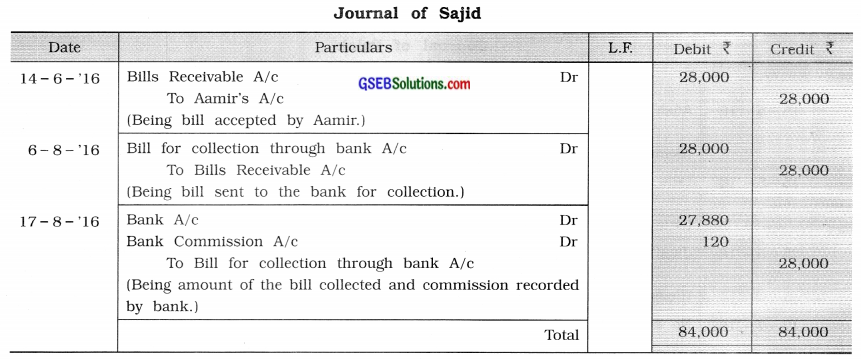

5. Dashrathbhai sold goods of ₹ 1,00,000 to Aakash on credit, for which Dashrathbhai drew a three months bill of ₹ 1,00,000 on Aakash, which Aakash accepted and returned. Aakash could not pay the money on the maturity date and noting charges amounted to ₹ 910 which Dashrathbhai paid in cash. Pass necessary journal entries in the book of both the parties.
Answer:
Journal of Dashrathbhai
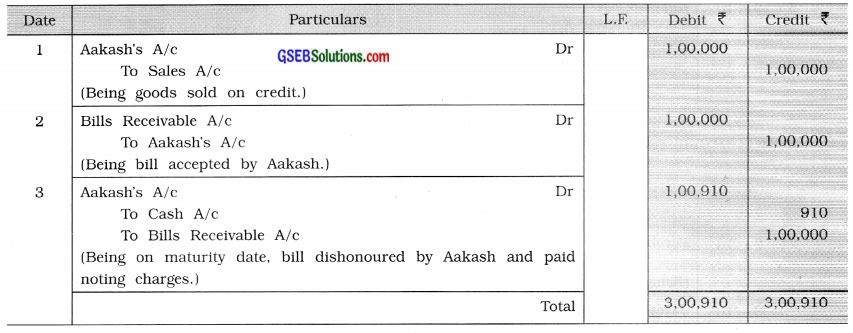

6. On 1-8-’16 Jayeshbhai sold goods of ₹ 60,000 to Dhaval on credit. On 3-8-’16, Jayeshbhai drew two months bill on Dhaval, which Dhaval accepted and returned. On 6-8-’16, Jayeshbhai discounted this bill with the bank at 10 % p. a. Dhaval could not pay the money on the maturity date. The bank debited an amount of ₹ 60,500 to Jayeshbhai’s account along with noting charges. Pass necessary journal entries in the books of Jayeshbhai and Dhaval.
Answer:
Journal of Jayeshbhai

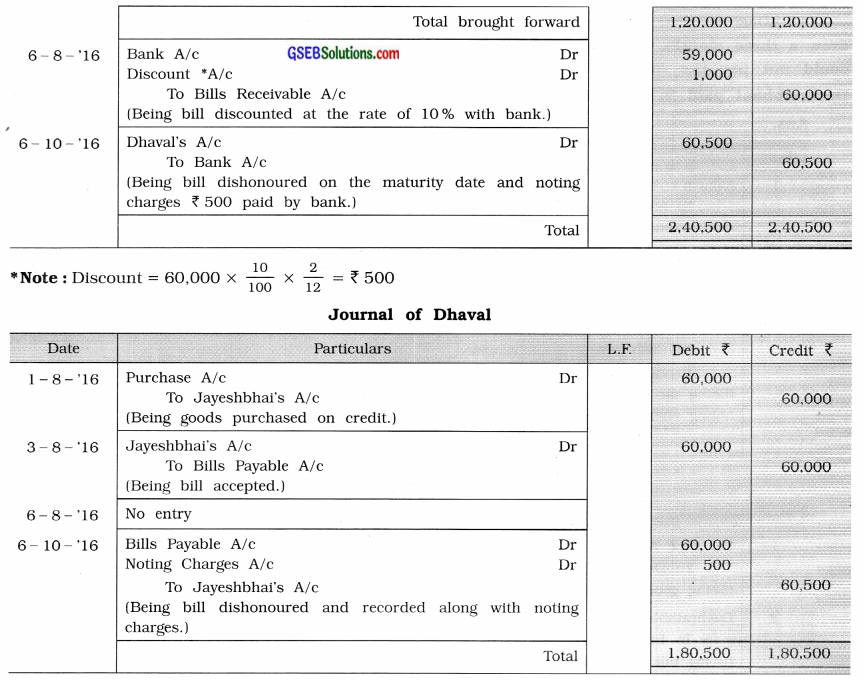
7. On 2-9-’16, Rajan sold goods of ₹ 89,000 to Namrata on credit. On 4-9-’16, Rajan drew a three months bill of ₹ 89,000 on Namrata, which Namrata accepted and returned. Rajan endorsed this bill to his creditor Arjun on 6 -9 -’16. The bill was dishonoured on the maturity date and Arjun paid noting charges of ₹ 440. Pass necessary journal entries in the books of all the parties.
Answer:
Journal of Rajan
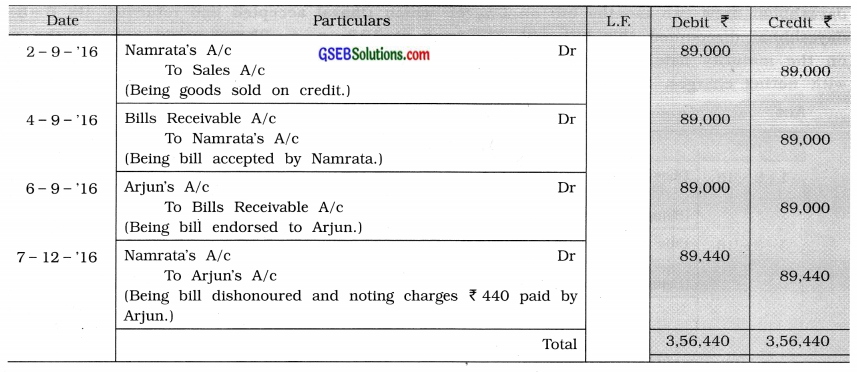
Journal of Namrata
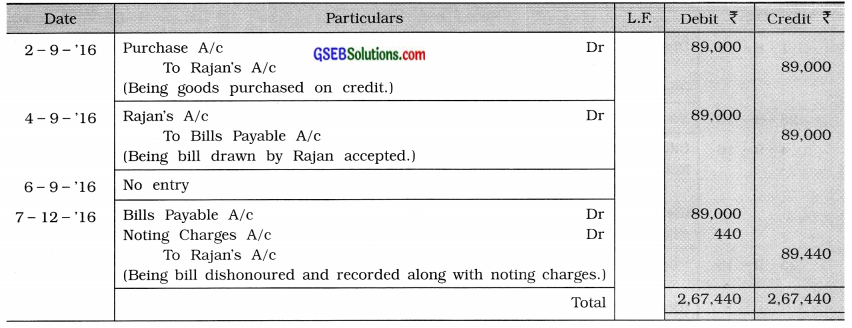
Journal of Arjun

![]()
8. On 1 – 8 – ’16 Dharmesh drew a one month bill of ₹ 75,000 on Avadh, which Avadh accepted and returned. On 28 -8 -’16, Dharmesh sent this bill for collection through bank. The bill was dishonoured on the maturity date. The bank debited the amount including noting charges ₹ 375 and bank commission ₹ 225 to Dharmesh’s account. On 25-9-’16, Avadh paid the entire amount payable to Dharmesh by a cheque. Pass necessary journal entries in the books of Dharmesh and Avadh.
Answer:
Journal of Dharmesh
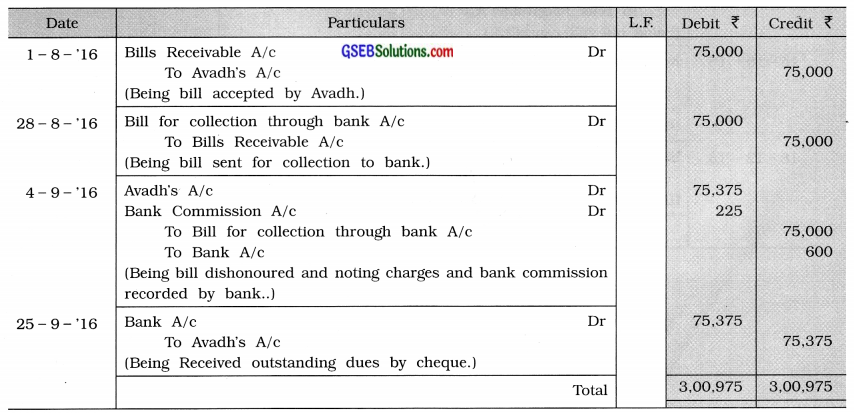
Journal of Avadh
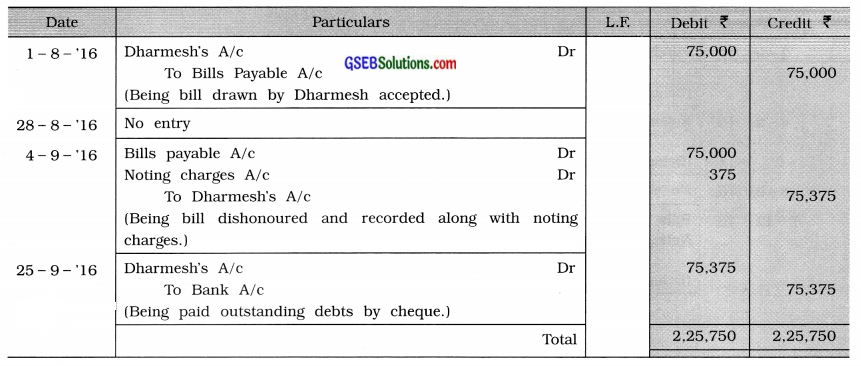
9. On 16 -6-’16, Sanjay sold goods of ₹ 78,000 to Hamish. On 20-6-’16, Sanjay drew a bill of the necessary amount and period of bill is four months on Harnish, which Harnish accepted and returned. On 15-10-’16, Harnish requested Sanjay to cancel the old bill and drew a new bill for two months period along with the interest ? 1,600. Sanjay agreed to the request of Hamish and drew a new bill for the required amount, which Hamish accepted. Harnish paid the money on the maturity date. Write journal entries in the books of Sanjay and Harnish.
Answer:
Journal of Sanjay
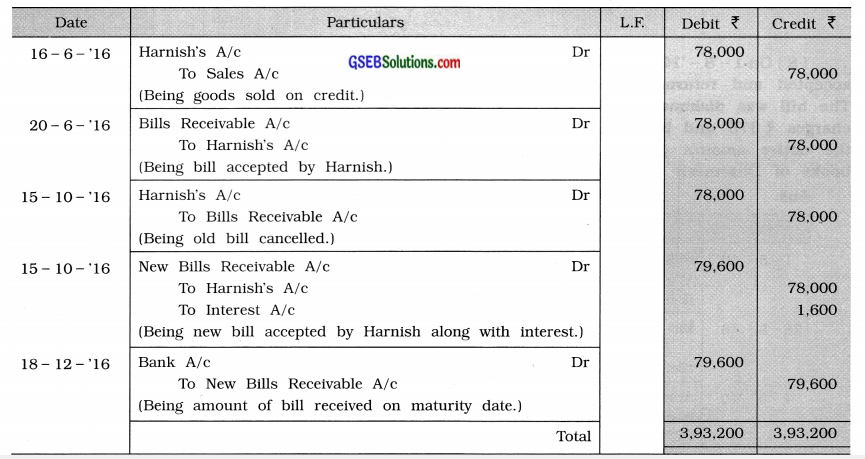
Journal of Harnish
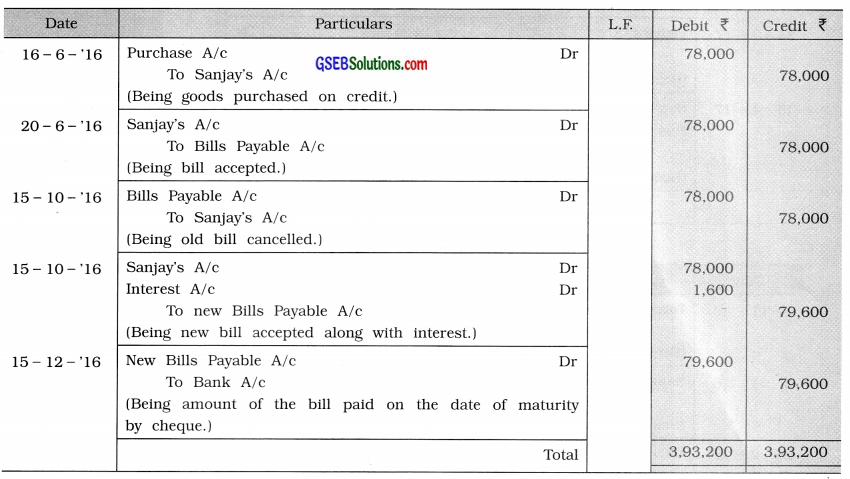
10. On 1 – 11 -’16, Kamalbhai sold goods of ₹ 2,50,000 to Vishal. On 3-11 -’16, Kamalbhai drew a four months bill of ₹ 2,50,000 on Vishal, which Vishal accepted on the same day. On 26-2-’17, Vishal gave a cheque of ₹ 50,000 and requested Kamalbhai to cancel the old bill and draw a new bill along with interest of ₹ 3,000 for 30 days. Kamalbhai agreed to the request of Vishal and drew a bill for the required amount including interest, which Vishal accepted. Before the maturity date on 24-3-’17, Vishal was declared insolvent and on 15-4-’17, received the final dividend at 40 paise from his receiver. Write journal entries in the books of Kamalbhai and Vishal.
Answer:
Journal of Kamalbhai
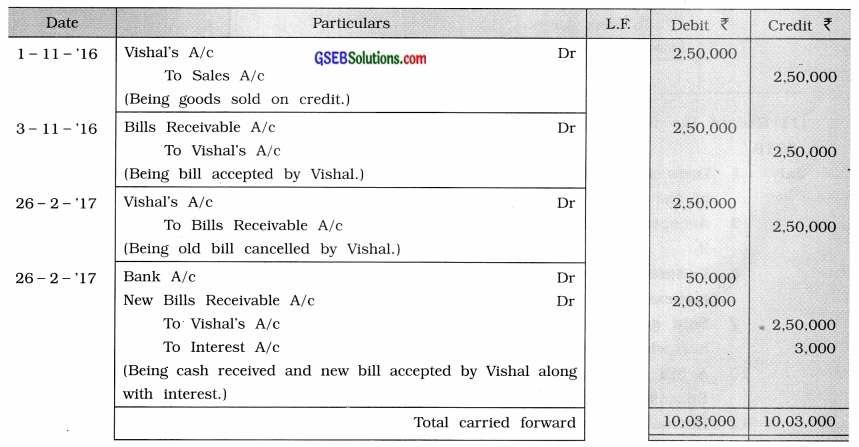

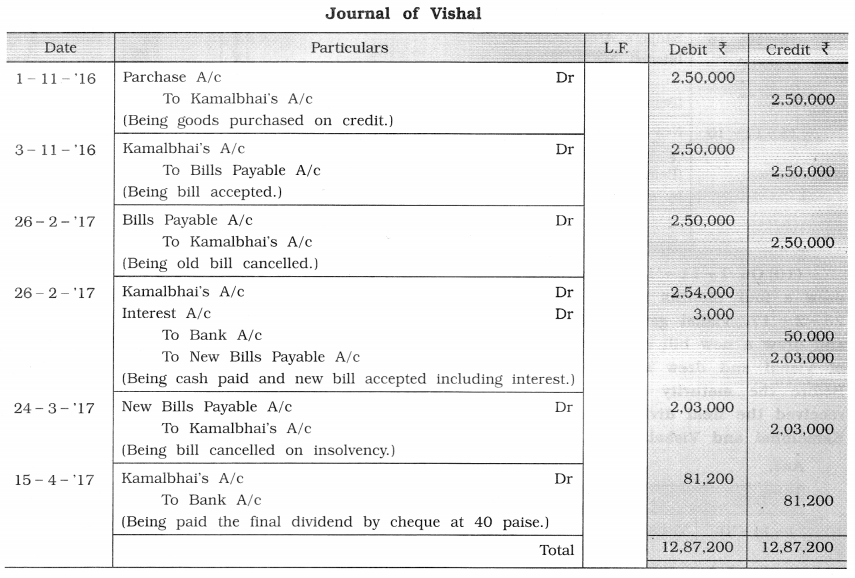
11. Record the following transactions in the books of Abraham: 2016
| 2016 July 1 |
Drew a bill of ₹ 24,000 on Karina, which she accepted and returned. The period of the bill is of 45 days. |
| 3 | Accepted a one month period bill of ₹ 28,000 drawn by Abhishek and returned it. |
| 5 | Endorsed a bill receivable of 32,500 received from Ranbir to Dipika in full settlement of an account of ₹ 33,000. |
| 7 | Sold goods of ₹ 48,000 to Priyanka and drew a two monthly bill of ₹ 40,000 on her which she accepted and paid the remaining amount by cheque immediately. |
| 10 | A bill of ₹ 55,000 drawn by us and accepted by Imran will mature on 16-7-’16. Because of this, bill was sent to bank for collection today. |
| 12 | Karina was declared insolvent and her receiver paid the final dividend at 40 paise. |
| 16 | Imran dishonoured the bill and the bank debited to our account an amount including noting charges ₹ 350 and charges for bill collection ₹ 250. |
| 18 | Imran gave a cheque of 50 % amount of the total accepted a new 2 months bill for the remaining included in the amount of the new bill. |
Answer:
Journal of Abraham
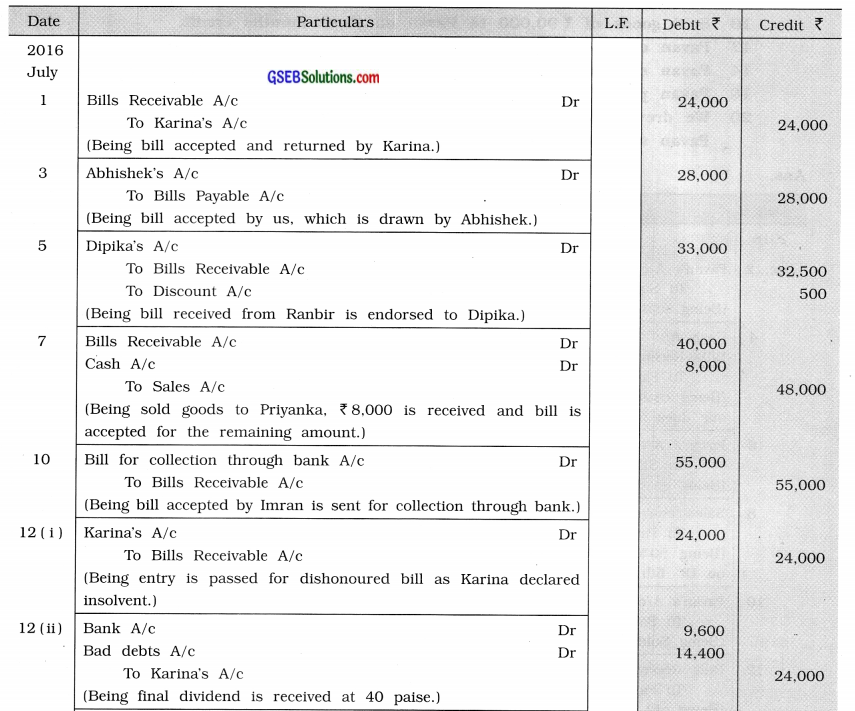
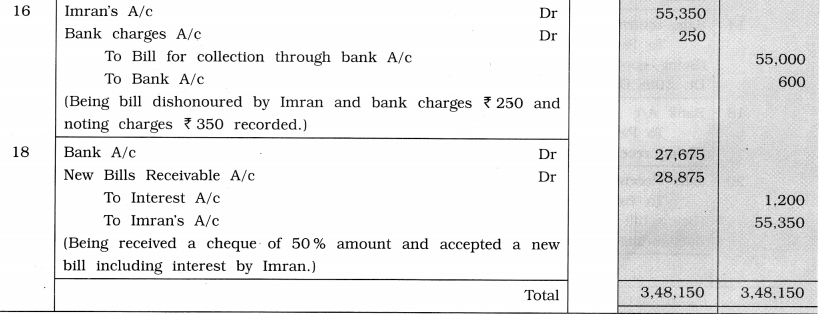
![]()
12. Record the following transactions in the books of Kiritbhai:
| 2016 Dec 2 | Sold goods of ₹ 49,000 to Pavan on two months credit. |
| 4 | Pavan paid cash ₹ 9,000 and sent a promissory note of two months period for the remaining amount. |
| 6 | Sold goods of ₹ 28,000 to Pavan at 10 % cash discount. |
| 8 | Pavan returned 50 % of goods from the goods purchased on Dt. 6th by him. |
| 10 | Sold goods of ₹ 90,000 to Pavan on three months credit. |
| 12 | Pavan endorsed his bill receivable of ₹ 45,000 in our favour |
| 14 | Pavan returned goods of ₹ 12,000 to us from his purchases on Dt. 10. |
| 18 | Pavan paid ₹ 16,000 by cheque against his account. |
| 20 | We drew a bill on Pavan for the required amount to settle his account, which Pavan accepted and returned. |
Answer:
Journal of Kiritbhai
